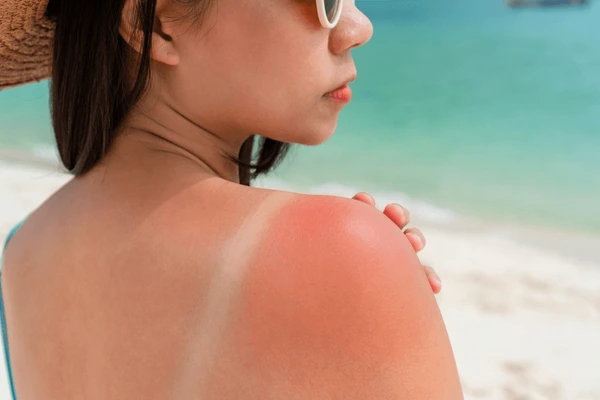Overview
Sunburn is skin injury brought on by excessive UV (ultraviolet) radiation exposure. Your skin might also become burned by UV rays coming from artificial sources like tanning beds. An actual radiation burn to your skin is a sunburn.
Multiple sunburns can cause skin cancer and accelerated ageing of the skin. In India, skin cancer is the most prevalent type of cancer.
By protecting your skin, you can reduce your risk of getting a sunburn. When spending any amount of time outdoors, it's crucial to be aware of your sun exposure.
At The Velvet Skin Centre, Indira Nagar, Dr. Asma offers effective sunburn treatment in Lucknow. Sunburn causes redness, peeling, and skin sensitivity that may lead to long-term damage if ignored. With soothing medical treatments, creams, and expert skincare guidance, we repair sun-damaged skin and restore its natural health. Patients achieve relief, healing, and stronger protection against future damage.
Cause
Too much ultraviolet (UV) light exposure results in sunburn. Sunlight or man-made sources like sunlamps and tanning beds both produce UV light. The wavelength of light known as UVA can damage skin over time by penetrating to its deepest layers. Sunburn is brought on by UVB rays, which penetrates the skin more superficially.
Skin cells are damaged by UV radiation. Erythema, or inflamed skin, or sunburn, is a result of the immune system's reaction, which involves boosting blood flow to the injured areas.
On chilly or gloomy days, sunburn is still possible. UV rays can reflect off of water, sand, and other surfaces, and they can also burn flesh.
Risk of Sun Burn
Risk factors for sunburn include:
- Having white skin and red hair
- Having a history of sunburn
- Living or vacationing somewhere sunny, warm or at high altitude
- Working outdoors
- Swimming or using baby oil or water to mist your skin, as moist skin tends to burn more than dry skin does
- Mixing outdoor recreation and drinking alcohol.
- Exposing bare skin to UV light on a regular basis from artificial sources like tanning beds or sunlight
- Taking a drug that makes you more likely to burn (photosensitizing medication)
According to this 2005 study, a sunburn is an inflammation that results in an erythema (rash) and edoema (swelling) because of a fluid buildup. Skin cells also undergo alterations as a result. It causes mast cells, which are important for the immune system, to decrease in number and the growth of sunburn cells, which have the potential to develop into cancer.
Don'ts for Carbon Peel:
- Don't leave the Carbon mask on longer than recommended, as it may cause irritation or dryness.
- Don't apply the Carbon mask on broken or irritated skin.
- Don't scrub or rub the Carbon mask vigorously while removing it, as it may damage your skin.
- Avoid Carbon Peel products, as excessive exfoliation can strip your skin of natural oils.
- Don't use Carbon. Peel masks if pregnant or breastfeeding without conferring with your healthcare provider.
- Don't apply the Carbon mask too close to the hairline, eyebrows, or eyelashes to avoid contact with these areas.
- Don't use Carbon Peel products if you have open wounds or active acne lesions.
- Don't use Carbon Peel masks if you have a history of skin allergies or sensitivities to any ingredients.
Symptoms of Sun Burn
People react to sunburn in different ways. Anyone can get a sunburn, but people with lighter skin are more vulnerable.
Following exposure, the skin may become:
- hot
- sensitive to the touch
- painful
- irritated
- itchy
- blistered
Light skin may turn red. Darker skin may change to a darker tone.
Symptoms of severe sunburn can affect the whole body. They include:
- fever
- chills
- headache
- nausea and vomiting
- a general feeling of being unwell
A person with severe sunburn may need medical attention.
Heat exhaustion or, more seriously, heatstroke can happen in extreme circumstances. Anyone experiencing any of the following symptoms ought to get emergency medical help:
div class="blog-article-content">
- low blood pressure
- fainting and dizziness
- rapid pulse
- general pain throughout the body
- extreme weakness
- shallow breathing
- changes in behavior, such as irritability, confusion, difficulty thinking, or hallucinations
When the core body temperature is higher than normal after sun exposure but not more than 104°F (40°C), a doctor will diagnose heat exhaustion. A person suffering from heatstroke will have a core body temperature of more than 104°F (40°C). Heatstroke is a potentially fatal illness that requires immediate care.
Symptoms of Sun Burn
A doctor will identify heat exhaustion when the body's core temperature is higher than usual after sun exposure but not more than 104°F (40°C). The core body temperature of someone experiencing heatstroke will be higher than 104°F (40°C). Heatstroke is a potentially lethal condition that needs to be treated right away.
The third degree of sunburn may require a skin graft. A surgeon transplants healthy skin from another area of your body after removing the dead skin. These burns have serious effects and take weeks or longer to cure.


